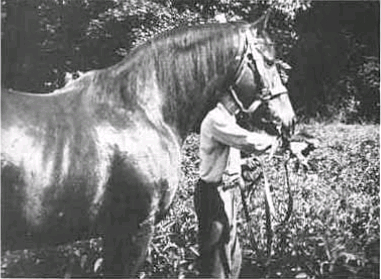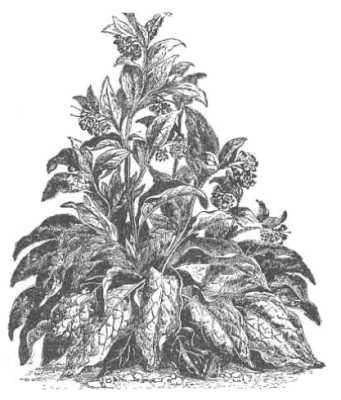
Feeding comfrey to livestock
 The
traditional farm use for comfrey has
been as livestock food. Once dried, comfrey contains up to 26%
crude protein, along with an assortment of minerals sucked from the
subsoil by eight foot deep roots. In addition, comfrey contains
less fiber than grass does (10.9% of dry weight), which makes it a good
feed for non-ruminants like pigs and chickens that have a hard time
digesting fiber. Anecdotal evidence exists for feeding comfrey to
horses, cows, donkeys, sheep, goats, chickens, and pigs, and at the
time Lawrence
Hills wrote his book (the early 1950s), race horses were being fed
comfrey as a way of keeping the animals in top condition.
The
traditional farm use for comfrey has
been as livestock food. Once dried, comfrey contains up to 26%
crude protein, along with an assortment of minerals sucked from the
subsoil by eight foot deep roots. In addition, comfrey contains
less fiber than grass does (10.9% of dry weight), which makes it a good
feed for non-ruminants like pigs and chickens that have a hard time
digesting fiber. Anecdotal evidence exists for feeding comfrey to
horses, cows, donkeys, sheep, goats, chickens, and pigs, and at the
time Lawrence
Hills wrote his book (the early 1950s), race horses were being fed
comfrey as a way of keeping the animals in top condition.
The question is --- how
much of these animals' traditional diets can be replaced by
comfrey? Little data existed at the time Hills' book was written,
but he suggested several hypotheses based on information about various
animals' known nutritional needs and a few on-the-ground trials.
One farmer noted that providing pigs unlimited comfrey allows you to
lower their storebought feed by 50%, and another farmer used the exact
same figures with his two horses. Comfrey can be used to replace
up to 10% of chickens' feed without lowering egg yield (though chickens
are the most sensitive to excess roughage of all the livestock
mentioned, so you might not want to go much higher than that.)
Lawrence suggests slowly increasing the proportion of comfrey included
in an animal's diet until signs of negative effects are noted.

When I first heard that
chickens eat comfrey, I got excited and tossed some in the
tractor...and my girls looked at me like I was crazy. Hills says
that most livestock will learn to like comfrey, but not in the fresh
form. The prickly hairs that make me use gloves when harvesting
can't be pleasant in an animal's mouth, but luckily the prickles are
merely a thin layer of silica stiffened with water. If you cut
the leaves and wilt them for a day or so, animals can eat the comfrey
with no ill effects --- I'll have to give that a shot! Other
farmers cut comfrey to make hay for the winter, or even turn goats and
sheep (who don't mind the prickles) onto a pasture of comfrey in the
spring and fall when grass pasture quality is at its worst.
If you're considering
comfrey as animal feed, you should cut your comfrey often so that it
never sends up flower stalks (like those shown in the second
image.) The percentages listed in this post are all for comfrey
in the leafy stage, while flower stalks have nearly double the fiber
and less than half the protein.
Have you tried feeding
comfrey to your animals? What did you think?
| This post is part of our Comfrey lunchtime series.
Read all of the entries: |
Want more in-depth information? Browse through our books.
Or explore more posts by date or by subject.
About us: Anna Hess and Mark Hamilton spent over a decade living self-sufficiently in the mountains of Virginia before moving north to start over from scratch in the foothills of Ohio. They've experimented with permaculture, no-till gardening, trailersteading, home-based microbusinesses and much more, writing about their adventures in both blogs and books.
Want to be notified when new comments are posted on this page? Click on the RSS button after you add a comment to subscribe to the comment feed, or simply check the box beside "email replies to me" while writing your comment.

I'd be interested in your thoughts on the toxicity of comfrey. The USDA (and the Australian and British equivalents) strongly warn against any ingestion of comfrey by humans, and advise against feeding it to animals as well.
The little investigation I've done suggests that they may have overreacted to some early research results that lumped comfrey in with other more toxic plants, but I'm not sure if that's enough reason to disregard the warnings.
There are certainly many people around who do eat it and feed it to animals and claim great benefits, but then if they're wrong you may destroy your liver!
Shannon ---- It depends on what you're looking for. If you're looking for the medicinal, common comfrey, you can get it just about anywhere --- just about everyone I know seems to have some, and you can just get a little start. On the other hand, I need to do some research to find a good source of Russian Comfrey. There are a few places on the internet, but I don't know if there's is really the highly productive Russian Comfrey or not. If you figure it out before I do, let me know!
Darren --- I grew up drinking a tea made from comfrey and mint leaves (gallons of it per week in the summer.) Then I read the reports on toxicity and quit, cold turkey. I haven't had time to really research it as an adult, but have stumbled across some folks who say the danger is overrated. I'm not sure I'm ready to eat it again, but I suspect it's probably better for chickens than masses of corn and soybeans --- but that has no data to back it up.
We feed comfrey to our chickens and they like it fine. I'm not familiar with different kinds of comfrey, ours seems to be "winged" and it is very fuzzy but no so that I need gloves to handle it. It grows like mad most of the year, even in partial shade and even without much watering.
I find the chickens are much more interested in anything I give them if I somehow suspend or wedge the leaves where they can rip at them as they would a living plant. They quickly loose interest in most things I just toss on the ground in their coop.
I have also seen it written that comfrey is too toxic to be the basis of feed for chickens and would like more info on this.
I'm leaning towards giving it to animals in small amounts (not as 50%+ of their diet!). I don't believe it's as bad as some make out, but I do think there's something there to be aware of and it's probably not good in large quantities.
It's got to be better than GM corn and soybeans, though :-).
Brett --- thanks for letting me know that at least your chickens like it! I was wondering if anyone had tried it in the last 50 years with success. I like your idea of hanging it up.
Darren --- one of these days I'll go a bit more research into the toxicity and make a post about it. It sure would be good to know at what concentration problems occur.
I tie up bundles of comfrey leaves and hang em up for my girls and let them eat as much as they can tolerate. They also have assess to as much chicken feed as they want so they can choose what they want. I think it's important to give them a variety of foods and they instinctively pick out what they need.
Another bass akwards way to feed comfrey to birds is to feed comfrey to the worm bin (red wigglers) and let the birds eat the worms. My ducks love red wigglers and I'm sure the protein and fat content is very high. I currently have a worm bin, nothing more than a pile of manure that has tons of worms in it and I add leaves, vines, and comfrey to it. I am overwintering it by surrounding it with nine straw bales and covering it with straw and a tarp.
Angel --- I used to drink comfrey-mint tea as a kid, and it was tasty. But I stopped when I heard about the cancer potential.
The plant is very good externally, though, as a wound poultice. I once healed up a huge gash in my foot that probably should have had stitches using comfrey leaves.
I have Bocking 4, not 14, the original root cuttings being obtained from the HDRA as it then was. The organisation is now known as GardenOrganic and has moved away from Lawrence Hills' original intention for his organisation and I gave up membership.
Bocking 4 has more protein than 14 and less allantoin so is preferred by poultry, and I eat it on a regular basis myself in stir-fries.I feed it fresh to goats, the only stock I presently keep, but have fed it to other stock.
I believe the crop has a lot of potential and I write a little more about it in my book "How not to make millions - but still live a rich rural life". I also blog at Blogspot under Old McDonald in Portugal.
I meant to post that there are several places that sell comfrey and have their details on the internet. One of them which sells Bocking 4, is Coe's Comfrey in N.C., USA. www.coescomfrey.com and the site is very informative, most of the information being taken directly from Lawrence Hill's writings.
It should be noted that Lawrence Hill did not "develop" the various cultivars of comfrey, something you will often read. To quote him "...it (was) clear that the only answer to the problem of about thirty distinct varieties....was to give them cultivar names which all hybrids have to have..". He gave them Bocking numbers as he was able to positively identify each cultivar, beginning of course with Bocking No.1 and so on. Bocking is the name of the place where he lived. He had several collections, or strains, from various people so the numbers are not consecutive within a strain, but chronologically as he identified a different cultivar, irrespective of which strain it was from.
Comfrey as medicine.
As stated above Comfrey is a very good bone knitter & used as a poultice is very effective & knitting the bone fibres. I also understand it to be like medicine for livestock, specifically chickens, so if they are feeling a bit off-colour they will enjoy access, not sure they need it all the time. One option is to grow it under a wire protection in the chicken coop along with other "salad" greens they can peck at it, without destroying the plant. Happy days!
Medicine Woman Kez Cares :>